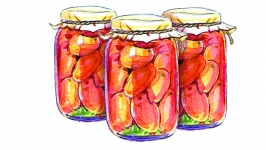Tomatoes 101
Just when northerners are savoring the last bites of their homegrown tomatoes, Floridians are giddy with anticipation for some tangy garden delights. Here’s how to bring tasty tomatoes to your kitchen—if they make it that far!
Research
Growing tomatoes in the South Florida home garden requires some experimentation. One variety might give poor production one season then be prolific the next. Set yourself up for success by planting several varieties each season. Tomatoes thrive when the days are hot and the nights are cool—from mid fall through late spring in our area, depending on the winter temps.
Starting
Place seeds in a shady spot away from direct sunlight at first. Do not let the starter mix dry out. Once seedlings grow true leaves—the ones that remain with the plant—harden them off by putting them in sunny locations for longer periods of time each day until about two to three inches tall. Transplant seedlings on an overcast day and premoisten the soil or wait until after rain. Plant them deep enough to cover the first set of true leaves to facilitate a strong root system. Note: If patience is low but you want a good variety, plant a few transplants from a garden store or local grower for a quicker harvest while waiting for seed starts to mature and become ready for transplant.
Sunlight
If you are saving that sunny spot for the best homegrown crop … this is it. Tomatoes need full sun. Anything less than eight hours will give you varied and sporadic results. During the hottest, sunniest days, don’t be alarmed if young tomato plants show a little droopiness. Keep the soil moist and they should pick back up by nightfall or after some watering or rain.
Support
If you chose a determinant variety, a tower, spiral, cage, or simple stake system will work. Determinates grow to a certain height then set fruit that generally ripens at the same time. The biggest challenge with determinates is supporting the fruit while it ripens. Indeterminate tomato plants—the wild and free cousins of determinants—will sprawl on the ground and take over the garden if left to their own devices. These varieties will require more attention and a stronger and more adaptable system for growth. (Search online for the Florida stake-and-weave method.)
Soil
For almost guaranteed success with tomatoes in our area, plant them in large containers, raised beds, or five-gallon buckets (drill holes for drainage). Tomatoes are deep-rooting and are partial to a constant stream of nutrients, not something easy to come by in the native South Florida soil. Before planting, amend the soil media organically with compost, eggshells, coffee grounds, or worm castings.
Water
Tomatoes thrive in evenly moist soil. Water regularly during drier days and at least once a week all other times and as fruit starts to ripen. Concentrate water at the roots as opposed to dousing the whole plant. Tomatoes are susceptible to a disease called powdery mildew, which is common in humid climates. Keeping soil evenly moist prevents blossom end rot and the cracking when fruit ripens.
Varieties
Consider space, desired tomato size, and intended use (canning, drying, freezing, fresh nibbling) when making your selection. If you want to save your seeds, choose an open-pollinated or heirloom variety whose seeds have been handed down for generations and will grow into an identical plant. Hybrids are a crossbreed of two varieties and show better disease resistance and higher yields. Seeds saved from these varieties will not produce the same plant. If you are first-time grower, start with a cherry tomato (transplant) as they tend to be less fussy.
Sweet 100 (hybrid, indeterminate)
Called “vine candy” by some, this variety produces hundreds of sweet tomatoes and has a long growing season. Awesome beginner variety. Great for snacking, pickling, and freezing.
Better Boy (hybrid, indeterminate)
This highly adaptable variety thrives in nearly any climate. It produces plump and juicy red fruit up to a pound. Offers great resistance to disease and soil-borne pests. Great in any salad.
Solar Fire (hybrid, determinate)
A heat- and humidity-tolerant variety developed by the University of Florida. Can be planted in early fall and will last into beginning of summer. The medium-to-large fruit is well-suited for sandwiches.
Beefmaster (hybrid, indeterminant)
Large, juicy tomatoes that live up to their description. Said to have some of the best flavor of all the large hybrids. Available in most garden stores as transplants. Slice fresh and put on a burger.
Yellow Pear (heirloom, indeterminate)
Dating back to the 17th century, this variety produces small pearshaped, lemon-yellow fruits. Yellow tomatoes tend to be lower in acidity. Their mildly tangy flavor makes them perfect for cold pasta salads.
Roma (heirloom, determinate)
Also known as the Italian tomato, this popular variety is often used to make sauces and paste. Cooking is said to intensify its flavor. Will hold up well for freezing to be cooked later. Great in bruschetta and on grilled pizza.
Brandywine (heirloom, indeterminate)
Dating back to 1885, one of the oldest varieties of tomato offers an intense flavor in the form of large beefsteak red-pink fruit. Fruit takes a long time to ripen after setting so ensure good support. Slice fresh and use in your Caprese salad.
Black Cherry (heirloom, indeterminate)
These “black” cherry tomatoes have a purple-brown color, adding a unique color spectrum to the garden. Described as having a rich, smoky flavor and great for snacking or in a tomato salad.






